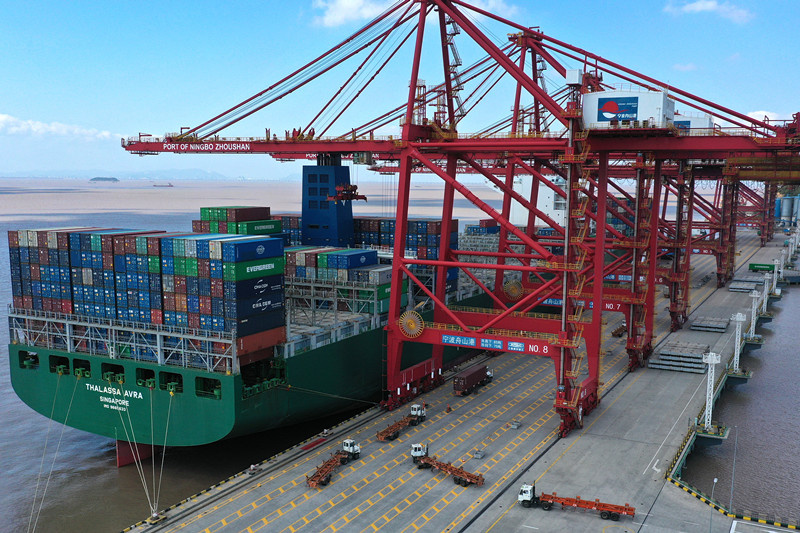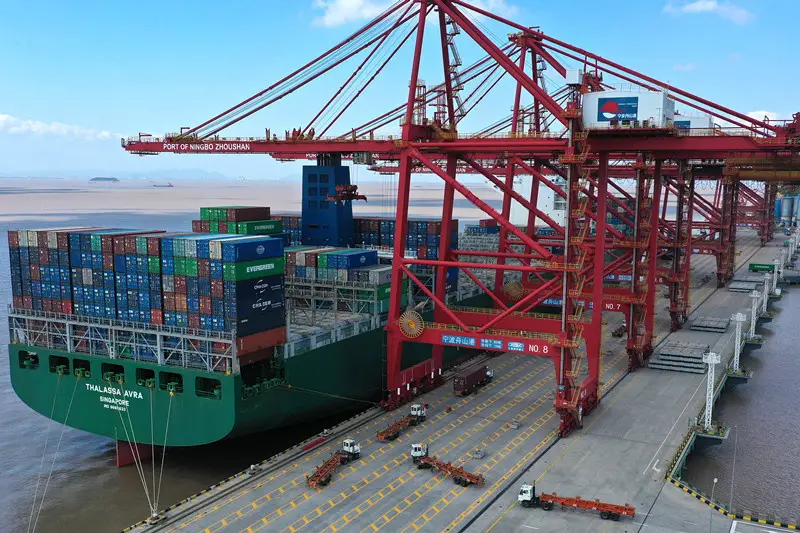By He Yin

Photo taken on October 20 shows bridge cranes unloading containers at a wharf in Jintang Island, Zhoushan, east China’s Zhejiang province. (Photo by Yao Feng/People’s Daily Online)
Chinese President Xi Jinping delivered an important speech at a grand gathering celebrating the 40th anniversary of the establishment of the Shenzhen Special Economic Zone (SEZ) in south China’s Guangdong province on October 14. His remarks have attracted wide attention from the international community.
While interpreting the global significance of China’s determination to promote reform and opening-up at a higher starting point, international observers said the Chinese leader once again emphasized the importance of reform and opening-up in Shenzhen, the forefront of China’s reform and opening up, and acknowledged the positive role of the policy in promoting the rapid development of China’s economy.
Shenzhen is the epitome of China’s reform and opening-up and the city will innovate and advance reform more boldly in the future, they said, noting that China’s continuous efforts to advance reform and opening-up will inject positive energy into global economic growth.
China unswervingly follows a win-win strategy of opening-up, through which the country can draw strength from the world and better benefit the world with its development, Xi noted.
China, as a major developing country with 1.4 billion people, a 900-million-strong labor force and 120 million market entities, welcomes the participation of more countries in the world in its reform and opening-up as well as the forming of a new pattern featuring extensive consultation, joint contribution and shared benefits.
As the COVID-19 pandemic has not yet been effectively brought under control across the world, and the world economy is suffering from the worst recession since the World War II, China’s efforts to promote reform and opening-up at a higher starting point have injected strong impetus into global economic recovery.
The fact that China’s economy has bucked the trend of a global recession and secured impressive performance has fully demonstrated the country’s confidence in advancing reform and opening-up at a higher starting point as well as the certainty that China’s development means greater benefits to the rest of the world.
The latest statistics suggest that China’s economy expanded 4.9 percent year on year in the third quarter and that the country’s economic growth of the first three quarters shifted from negative to positive.
China’s economy is moving faster back on track, pointed out the international community.
China was pulling up the global numbers, said Gita Gopinath, Chief Economist of International Monetary Fund (IMF).
China’s growth amid the COVID-19 pandemic is a positive impulse for the world economy, noted IMF Managing Director Kristalina Georgieva.
China became a vital refuge for many of them (U.S. companies) as China’s rebounding consumer economy helped offset the damage from tumbling sales back home, according to an article published on The Wall Street Journal.
Those who recognize the trend are wise and those who ride the trend will win.
International economic connectivity and exchanges are still the objective requirements of world economic development.
Standing on the right side of history, China has kept up with the times, deepened reform on all fronts and expanded all-around opening up.
With lower overall tariffs, shorter negative lists for foreign investment, easier market access, more transparent market rules, and a more attractive business environment, the country has closely connected its domestic market, the largest one in the world, with the global market, realizing a virtuous circle and mutual promotion between the domestic market and global market at a larger scale and with greater efficiency and stronger dynamism while opening up vast development opportunities for itself and various countries in the world.
With practical efforts to promote higher-level opening-up, China has won universal recognition and trust from the international community.
Data from the Organization for Economic Co-operation and Development (OECD) show that China’s restrictions on foreign investment have declined rapidly since 2013, and the decline is one of the sharpest among major economies.
China has made great achievements in optimizing business environment, said a report released by the World Bank.
Nearly 70 percent of the interviewed U.S. companies are optimistic about the business prospects of the Chinese market in the next five years, according to a survey carried out by the U.S.-China Business Council.
The Chinese market is highly attractive to most European Union (EU) companies in China, and over 60 percent of the respondents believe that China is still one of their top three investment destinations, said a report jointly released by the EU Chamber of Commerce in China and Roland Berger, a leading global consultancy.
In the first seven months of this year, the total volume of foreign trade between the 27 EU member states and China reached 328.7 billion euros (about $389.48 billion), an increase of about 2.6 percent year on year, suggested data released by Eurostat, the statistical office of the EU. The result made China become the largest trading partner of EU for the first time.
Facts have proved that China’s continuously increasing attractiveness of “bringing in” and competitiveness of “going global” are strong driving forces for win-win cooperation with countries in the world.
China’s reform and opening-up meets its people’s aspiration for development, innovation and a better life. It also meets the global trend toward development, cooperation and peace.
By joining hands with various countries in the world to build a community with shared future for mankind, China is trying to blaze a trail for peaceful, open, cooperative, and common development that will lead the world to a better future.
While interpreting the global significance of China’s determination to promote reform and opening-up at a higher starting point, international observers said the Chinese leader once again emphasized the importance of reform and opening-up in Shenzhen, the forefront of China’s reform and opening up, and acknowledged the positive role of the policy in promoting the rapid development of China’s economy.
Shenzhen is the epitome of China’s reform and opening-up and the city will innovate and advance reform more boldly in the future, they said, noting that China’s continuous efforts to advance reform and opening-up will inject positive energy into global economic growth.
China unswervingly follows a win-win strategy of opening-up, through which the country can draw strength from the world and better benefit the world with its development, Xi noted.
China, as a major developing country with 1.4 billion people, a 900-million-strong labor force and 120 million market entities, welcomes the participation of more countries in the world in its reform and opening-up as well as the forming of a new pattern featuring extensive consultation, joint contribution and shared benefits.
As the COVID-19 pandemic has not yet been effectively brought under control across the world, and the world economy is suffering from the worst recession since the World War II, China’s efforts to promote reform and opening-up at a higher starting point have injected strong impetus into global economic recovery.
The fact that China’s economy has bucked the trend of a global recession and secured impressive performance has fully demonstrated the country’s confidence in advancing reform and opening-up at a higher starting point as well as the certainty that China’s development means greater benefits to the rest of the world.
The latest statistics suggest that China’s economy expanded 4.9 percent year on year in the third quarter and that the country’s economic growth of the first three quarters shifted from negative to positive.
China’s economy is moving faster back on track, pointed out the international community.
China was pulling up the global numbers, said Gita Gopinath, Chief Economist of International Monetary Fund (IMF).
China’s growth amid the COVID-19 pandemic is a positive impulse for the world economy, noted IMF Managing Director Kristalina Georgieva.
China became a vital refuge for many of them (U.S. companies) as China’s rebounding consumer economy helped offset the damage from tumbling sales back home, according to an article published on The Wall Street Journal.
Those who recognize the trend are wise and those who ride the trend will win.
International economic connectivity and exchanges are still the objective requirements of world economic development.
Standing on the right side of history, China has kept up with the times, deepened reform on all fronts and expanded all-around opening up.
With lower overall tariffs, shorter negative lists for foreign investment, easier market access, more transparent market rules, and a more attractive business environment, the country has closely connected its domestic market, the largest one in the world, with the global market, realizing a virtuous circle and mutual promotion between the domestic market and global market at a larger scale and with greater efficiency and stronger dynamism while opening up vast development opportunities for itself and various countries in the world.
With practical efforts to promote higher-level opening-up, China has won universal recognition and trust from the international community.
Data from the Organization for Economic Co-operation and Development (OECD) show that China’s restrictions on foreign investment have declined rapidly since 2013, and the decline is one of the sharpest among major economies.
China has made great achievements in optimizing business environment, said a report released by the World Bank.
Nearly 70 percent of the interviewed U.S. companies are optimistic about the business prospects of the Chinese market in the next five years, according to a survey carried out by the U.S.-China Business Council.
The Chinese market is highly attractive to most European Union (EU) companies in China, and over 60 percent of the respondents believe that China is still one of their top three investment destinations, said a report jointly released by the EU Chamber of Commerce in China and Roland Berger, a leading global consultancy.
In the first seven months of this year, the total volume of foreign trade between the 27 EU member states and China reached 328.7 billion euros (about $389.48 billion), an increase of about 2.6 percent year on year, suggested data released by Eurostat, the statistical office of the EU. The result made China become the largest trading partner of EU for the first time.
Facts have proved that China’s continuously increasing attractiveness of “bringing in” and competitiveness of “going global” are strong driving forces for win-win cooperation with countries in the world.
China’s reform and opening-up meets its people’s aspiration for development, innovation and a better life. It also meets the global trend toward development, cooperation and peace.
By joining hands with various countries in the world to build a community with shared future for mankind, China is trying to blaze a trail for peaceful, open, cooperative, and common development that will lead the world to a better future.
 Menu
Menu
 China continues improving driving forces for win-win cooperation
China continues improving driving forces for win-win cooperation
















